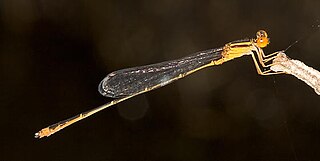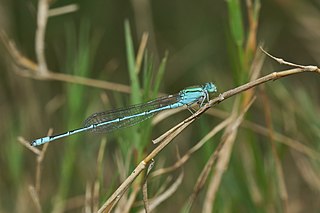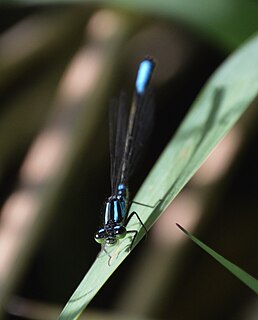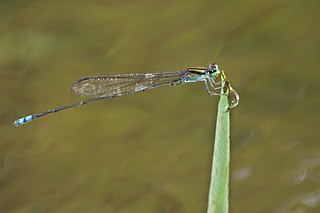
The small red-eyed damselfly is a member of the damselfly family Coenagrionidae. It is very similar to the red-eyed damselfly.

Ischnura aurora, golden dartlet, also known as the aurora bluetail, is a species of damselfly in the family Coenagrionidae.

Pseudagrion newtoni, the harlequin sprite, is a species of damselfly in the family Coenagrionidae.

Pseudagrion sublacteum or cherry-eye sprite is a species of damselfly in the family Coenagrionidae. It is found in Africa from northern South Africa to West and North Africa, and in the Middle East.

Eastern forktail is a member of the damselfly family Coenagrionidae.

The marsh bluet is a damselfly species in the family Coenagrionidae.

The orange bluet is a species of damselfly in the family Coenagrionidae.

Nehalennia is a genus of very small damselflies in the family Coenagrionidae. Most of the species are commonly known as Sprites. One species, N. speciosa occurs in Eurasia; the rest in North and South America.

Pseudagrion citricola is a species of damselfly in the family Coenagrionidae. It is commonly known as the yellow-faced sprite.

Coenagrion resolutum, the taiga bluet, is a damselfly which is part of the family of Coenagrionidae found in Europe and North America.

Pseudagrion caffrum, the springwater sprite is a species of damselfly in the family Coenagrionidae. It is found in Lesotho, South Africa and Swaziland. Its natural habitats include montane streams with grassy banks.
Proischnura polychromatica, the mauve bluet, is a small species of damselfly in the family Coenagrionidae. It is endemic to a small area of Cape Province in South Africa. The adult male has a mauve sheen to its dark-coloured body, a bronze-green thorax striped with mauve, and a pale brown abdomen with a bronze-green dorsal stripe. The female is mainly pale brown. The natural habitat of this damselfly is transient pools in stream beds with floating vegetation, especially sedges. Although previously more widespread, it is now known from a single location where it is threatened by the encroachment of cattle and the loss of suitable habitat. For these reasons, the International Union for Conservation of Nature has rated it as "endangered".

Ceriagrion coromandelianum is a species of damselfly in the family Coenagrionidae. it is commonly known as coromandel marsh dart and yellow waxtail. This species can be found in South Asian countries such as: India, Sri Lanka, Pakistan and Nepal.

Paracercion malayanum, Malay lillysquatter, is a species of damselfly in the family Coenagrionidae. It is known to occur in India, Sri Lanka, Nepal, Java, Philippines and Thailand.

Pseudagrion malabaricum, Malabar sprite, jungle grass dart, is a species of damselfly in the family Coenagrionidae. It is found in India, Sri Lanka, and Myanmar.

Pseudagrion rubriceps, saffron-faced blue dart, is a species of damselfly in the family Coenagrionidae. It is found in many tropical Asian countries.

Pseudagrion decorum, elegant sprite or three striped blue dart, is a species of damselfly in the family Coenagrionidae. It is found in many tropical Asian countries.

Ischnura erratica, the swift forktail, is a species of damselfly in the family Coenagrionidae. It is native to the Pacific Northwest, ranging from British Columbia to northern California.

Pseudagrion indicum, yellow-striped blue dart or yellow-striped dart, is a species of damselfly in the family Coenagrionidae. It is found only in Western Ghats of India.

Ischnura rubilio, western golden dartlet, is a species of damselfly in the family Coenagrionidae. It is found in Indian subcontinent and Iran.
























